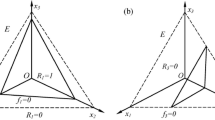Abstract
Experimental studies of a microbial food chain involving organic carbon substrates,Enterobacter aerogenes, and ciliate protozoansParamecium primaurelia andDldinium nasutum were conducted in stirred, aerated batch cultures. Quantitative measurements were made of organic carbon levels and of cell numbers, mean cell volumes, and total biovolumes for all three microbial populations. A mathematical model based on Monod kinetics was developed to describe this four-trophic level predator-prey system. The model was formulated in terms of biovolume, which is the product of cell numbers and mean cell size, and includes terms for bio-volume decay. Batch culture data were used to derive parameter values, and model simulations were compared to experimental results. Despite the significance ofParamecium-Didinium studies in ecological literature, the entire food chain has not been previously studied or modeled.
Similar content being viewed by others
References
Allen SL, Nerad TA (1978) Method for the simultaneous establishment of many axenic cultures ofParamecium. J Protozool 25:134–139
Bader FG, Tsuchiya HM, Fredrickson AG (1976) Grazing of ciliates on blue-green algae: Effect of ciliate encystment and related phenomena. Biotech Bioeng 18:311–332
Bonomi A, Fredrickson AG (1976) Protozoan feeding and bacterial wall growth. Biotech Bioeng 18:239–252
Bruns PJ (1973) Cell density as a selective parameter inTetrahymena. Exptl Cell Res 79: 120–126
Canale RP (1970) An analysis of models describing predator-prey interaction. Biotech Bioeng 12:353–378
Canale RP, Lustig TD, Kehrberger PM, Salo JE (1973) Experimental and mathematical modeling studies of protozoan predation on bacteria. Biotech Bioeng 15:707–728
Canale RP, Cheng FY (1974) Oxygen utilization in bacterial-protozoan community. J Envir Eng Div ASCE 100:171–185
Cook JR (1961)Euglena gracilis in synchronous division. 1. Dry mass and volume characteristics. Plant and Cell Physiol 2:199–202
Curds CR, Cockburn A (1971) Continuous monoxenic culture ofTetrahymena pyriformis. J Gen Microbiol 66:95–108
Drake JF, Jost JL, Fredrickson AG, Tsuchiya HM (1968) The food chain. In: Saunders JF (ed) Bioregenerative systems. NASA Sp-165, Washington, D.C., pp 87–95
Drake JF, Tsuchiya HM (1973) Differential counting in mixed cultures with Coulter counters. Appl Microbiol 26:9–13
Fredrickson AG (1977) Behavior of mixed cultures of microorganisms. Ann Rev Microbiol 31:63–87
Gause GF (1971) The struggle for existence. The Williams and Wilkins Co. Dover Edition, New York
Habte M, Alexander M (1978) Protozoan density and the coexistence of protozoan predators and bacterial prey. Ecology 59:140–146
Hamilton RD, Preslan JE (1970) Observations on the continuous culture of a planktonic phagotrophic protozoan. J Exp Marine Biol and Ecol 5:94–104
Herbert D, Elsworth R, Telling RC (1956) The continuous culture of bacteria: A theoretical and experimental study. J Gen Microbiol 14:601–622
Hewett SW (1980) The effect of prey size on the functional and numerical responses of a protozoan predator to its prey. Ecology 61:1075–1081
Jost JL, Drake JF, Tsuchiya HM, Fredrickson AG (1973) Microbial food chains and food webs. J Theor Biol 41:461–484
Jost JL, Drake JF, Fredrickson AG, Tsuchiya HM (1973) Interactions ofTetrahymena pyriformis, Escherichia coli, Azotobacter vinelandii, and glucose in a minimal medium. J Bacteriol 113:834–840
Kent EB (1981) Life history responses to resource variation in a sessile predator, the ciliate protozoanTokophrya lemnarum Stein. Ecology 62:296–302
Luckinbill LS (1973) Coexistence in laboratory populations ofParamecium aurelia and its predatorDidinium nasutum. Ecology 54:1320–1328
Luckinbill LS (1974) The effects of space and enrichment on a predator-prey system. Ecology 55:1142–1147
Luckinbill LS (1979) Regulation, stability, and diversity in a model experimental microcosm. Ecology 60:1098–1102
Luckinbill LS (1979) Selection and ther/K continuum in experimental populations of protozoa. Amer Nat 119:427–437
Maly EJ (1978) Stability of interaction betweenDidinium andParamecium: Effects of dispersal and predator time lag. Ecology 59:733–741
May RM (1973) Stability and complexity in model ecosystems. Monographs in Population Biology 6. Princeton University Press, Princeton
Monod J (1942) Recherches sur la croissance des cultures bacteriennes. Herman & Cie, Paris
Monod J (1949) The growth of bacterial cultures. Ann Rev Microbiol 3:371–394
Proper G, Garver JC (1966) Mass culture of the protozoanColpoda steini. Biotech Bioeng 8: 287–296
Salt GW (1974) Predator and prey densities as controls of the rate of capture by the predatorDidinium nasutum. Ecology 55:434–439
Taylor WD, Berger J (1976) Growth ofColpidium campylum in monoenic batch culture. Can Jour Zool 54:392–398
Taylor WD, Gates MA, Berger J (1976) Morphological changes during the growth cycle of axenic and monoxenicTetrahymena pyriformis. Can Jour Zool 54:2011–2018
Tsuchiya HM, Drake JF, Jost JL, Fredrickson AG (1972) Predator-prey interactions ofDictyostelium discoideum andEscherichia coli in continuous culture. J Bacteriol 110:1147–1153
Tsuchiya HM, Jost JL, Fredrickson AG (1972) Intermicrobial symbiosis. Proc IV IFS: Ferment Tech Today 43–49
van den Ende P (1973) Predator-prey interactions in continuous culture. Science 181:562–564
Watson PJ, Ohtaguchi K, Fredrickson AG (1981) Kinetics of growth of the ciliateTetrahymena pyriformis onEscherichia coli. J Gen Microbiol 122:323–333
Williams, FM (1971) Dynamics of microbial populations. In: Patten BC (ed) Systems analysis and simulation in ecology. vol.1, Academic Press, New York, pp 198–267
Author information
Authors and Affiliations
Rights and permissions
About this article
Cite this article
Graham, J.M., Canale, R.P. Experimental and modeling studies of a four-trophic level predator-prey system. Microb Ecol 8, 217–232 (1982). https://doi.org/10.1007/BF02011426
Issue Date:
DOI: https://doi.org/10.1007/BF02011426




